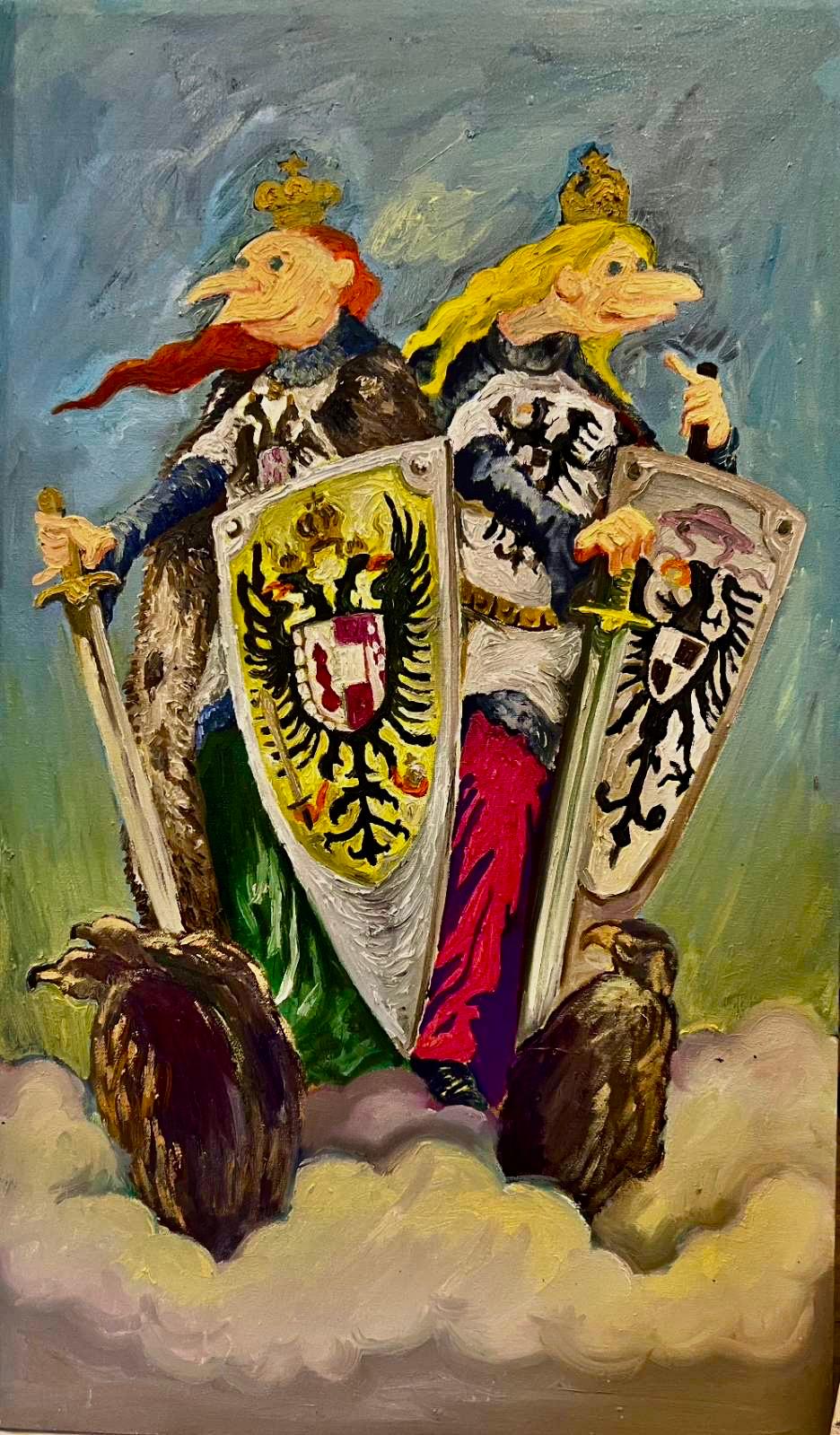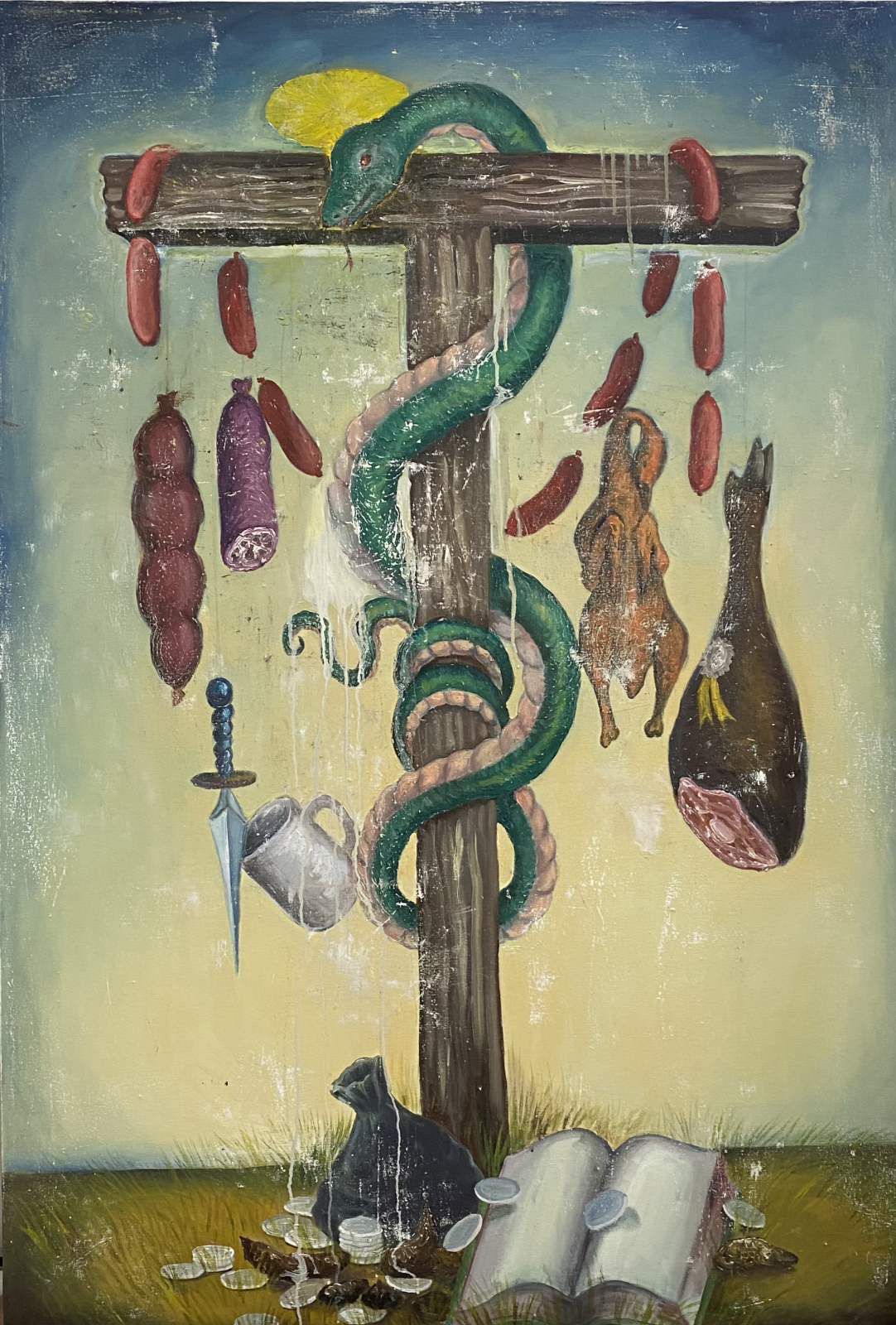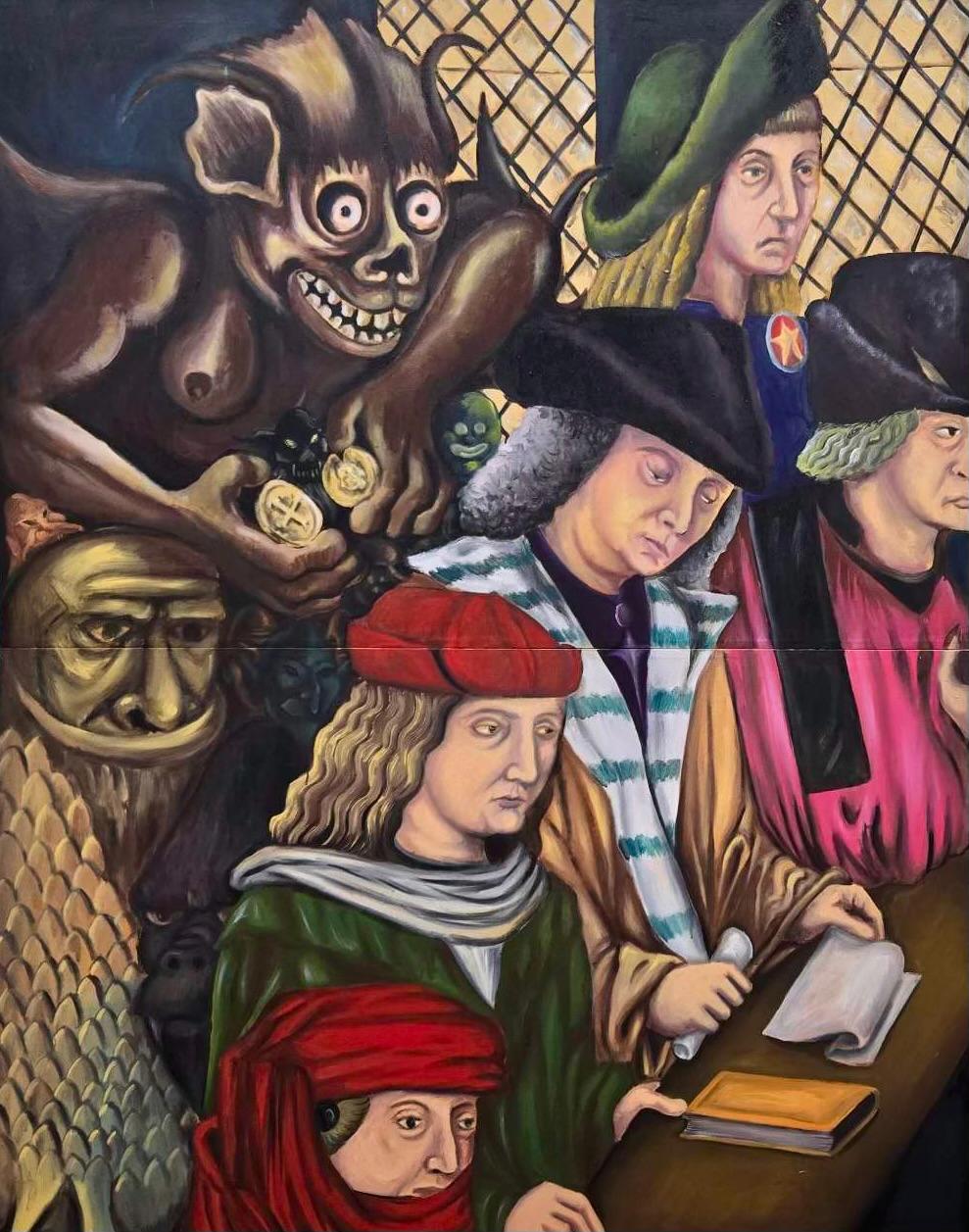Current Exhibition
Korean
Manuel Ocampo (b.1965- Philippines)
Guardians of Beauty, 2024
Oil on canvas
103 x 61 cm
"Guardians of Beauty," employs the formal language of classical European history painting-a style itself synonymous with Western imperial power-to stage a critical interrogation of the very ideals it was designed to glorify.
The painting presents two maidens, posed as heraldic caryatids upon a heavenly cloud. They are adorned in meticulously rendered medieval garb, holding aloft the shields of two formidable imperial traditions: the Double-Headed Eagle of secular empire and the Papal Eagle of spiritual dominion. They are surrounded by a host of noble eagles, a tableau intended to evoke divine sanction and celestial order.
Yet, this façade of nobility is deliberately subverted. The maidens, one blond and one red haired, are painted not as paragons of timeless beauty, but as caricatures. Their features are distorted-possessing long, beaklike noses, pronounced overbites, and small, beady eyes. This aesthetic dissonance is the core of the piece's critique.
The title, "Guardians of Beauty," is deeply ironic. These figures are not beautiful by any objective standard, but they are presented as the arbiters of beauty from their privileged, "heavenly" vantage point. They represent the imposed and often absurd standards of aesthetic and cultural value that have been historically weaponized by colonial and imperial powers.
The two eagles are central to this reading. The Double-Headed Eagle symbolizes the geopolitical machinery of empire-the conquest, annexation, and administration that forced foreign norms upon colonized lands. The Papal Eagle represents the ideological and spiritual arm of this expansion, the "civilizing mission" that justified cultural erasure under the guise of salvation. Together, they are the twin engines of cultural hegemony.
The maidens, therefore, are not merely guardians; they are personifications of this hegemonic force. Their cartoonish, almost monstrous visages reveal the grotesque nature of an ideology that claims universal beauty while enforcing a narrow, self-serving standard. The cloud they stand on is not a true heaven, but a constructed realm of power, a mythologized hierarchy designed to legitimize their authority and devalue all other forms of beauty, culture, and existence that fall outside its rigid framework.

Manuel Ocampo (b.1965- Philippines)
Vegan Crucifixion, 2022
Oil on canvas
180 x 120 cm
"Vegan Crucifixion," is a visceral and satirical tableau that interrogates the complex, often contradictory, relationships between sacrifice, consumption, dogma, and desire. It seeks to dismantle and examine the altars at which modern society worships-be they religious, culinary, or ideological.
The central image of the cross, a universal symbol of ultimate sacrifice, is re-contextualized. It is no longer an instrument of divine offering but a butcher's rack, adorned with the carcasses and curated meats we consume without witness: the hanging sausages, the glazed Peking duck, the revered Jamón Serrano. These are the martyrs of our daily sustenance, their sacrifice rendered mundane and decorative.
Presiding over this scene is the serpent, crowned with a saint's halo. This conflation of the biblical tempter and the sanctified being challenges our ingrained notions of sin and virtue. Is the snake a demonic force entwined in our cycle of consumption, or is it an enlightened saint, its halo a symbol of the forbidden knowledge of the consequences of our appetites? The white metal cup-a potential grail or a sterile, modern vessel-stands empty, suggesting a communion denied or a sacrament that has lost its meaning.
At the base of this structure lies the fallout of this consumption. The open book represents the rigid texts-religious, ethical, nutritional-that guide (or fail to guide) our choices. Scattered around it is excrement, the undeniable, biological conclusion of consumption. It is the raw, abject truth that remains after the feast, a memento mori that refuses to be spiritualized or sanitized.
The title, "Vegan Crucifixion," is the central paradox. It points not to the absolution of non-participation, but to the inescapable violence inherent in a world built on consumption. In this painted world, everyone and everything is implicated in a cycle of sacrifice, from the haloed tempter to the saintly consumer. The painting does not offer an answer but holds a mirror to the messy, often hypocritical, and deeply visceral theater of our daily devotions.

Manuel Ocampo (b.1965- Philippines)
Somewhere in Europe, 2025
Oil on canvas
244 x 213 cm
"Somewhere in Europe," is a contemporary allegory examining the intricate and often shadowy theatre of the global art market. The scene presents a council of five money-lenders-our modern-day arbiters of taste and value-gathered around the sacred ledger of accounts. Their world, however, is not one of pure commerce, but one haunted by the spectral forces that underpin it.
The demon proffering gold coins and the grotesque, avaricious idol represent the ancient, insatiable spirits of greed and speculation that have always shadowed accumulation. They are the silent patrons of this transaction. Emerging from the darkness, the faces of the gorilla and the problematic black figure are deliberate, uncomfortable citations. They invoke a history of colonial exploitation, racist caricature, and the "primitive" as a commodified aesthetic-foundational, often unacknowledged, capital upon which much of Western art and wealth has been built.
This entire narrative is meticulously framed by an ornate, silver and violet-blue floral pattern. This decorative border symbolizes the beautiful, seductive, and institutional facade of the art world-the galleries, the auctions, the vernissages-that elegantly contains and sanitizes its more troubling realities. Yet, even within this frame, the devil is present, holding a blank card. This is the ultimate, ambiguous instrument of modern value: a credit card without a limit, a playing card in a fixed game, an unsigned contract. Its emptiness is its power; it invites the viewer to project their own complicity, desires, and debts onto it.
"Somewhere in Europe" is not a place, but a condition. It is a space where aesthetic value, historical baggage, and financial power converge.
